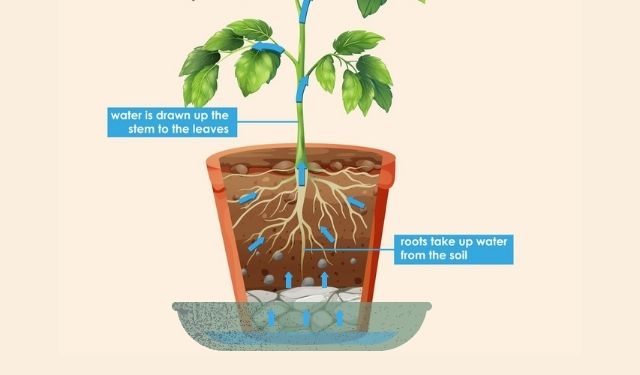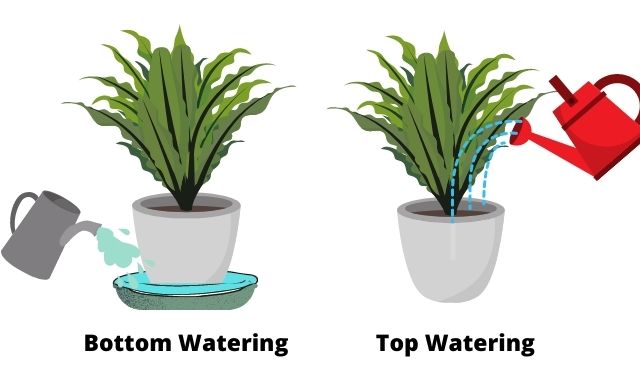
One of the most important aspects of caring for plants is fertilizing them, but many times, especially with bottom watering, you may not know where to begin.
During the growing season, a water-soluble fertilizer should be mixed with the water during bottom watering. When fertilizer is mixed with water, the nutrient can move upward and soak into the soil during routine watering.
Bottom watering encourages root growth and, when combined with fertilizer, can also aid in promoting plant growth.
However, there are several crucial factors to take into account while fertilizing to make sure you are doing it correctly, which we will discuss further in this post.
Table of Contents
How Much Fertilizer to Add?
Because they lack the benefits of nature, which naturally supply nutrients to the soil through rainfall, decomposing leaves, and dead insects, houseplants require fertilizer.
By giving the plants vital nutrients, fertilizer is added when bottom watering to mimic nature’s processes.
Plants should only receive a very modest amount of fertilizer. For example, you should use half the suggested amount per gallon of water when using an all-purpose inorganic soluble fertilizer like Miracle Grow (24-8-16).
Only a very minimal amount of fertilizer is required for plants to perform their biological tasks and develop into healthy plants.
There are many various kinds of fertilizer, and depending on the fertilizer, their NPK values can range from 0 to 30% per volume.
Because the NPK nutrient mix is typically way too high up in the (10 to 30) range (for example, 20-20-20), which may be too much for your plant to handle, you should only apply half the suggested amount of fertilizer when using inorganic fertilizer.
However, if you are using an organic fertilizer, such compost or vermiculture, you can add the suggested amounts to your soil because they are less concentrated in the NPK range, being somewhere in the NPK range of (2-2-2) or even lower (1-2-1).
Applying organic fertilizer in the prescribed quantity per volume of liquid is possible.
Additionally, these organic fertilizers enrich the soil with helpful organisms like bacteria and fungi, which can enhance the soil’s ability to support plant growth and health.
I have found that Miracle-Gro Soluble fertilizer produces the finest results. It offers excellent value for the money and is durable. Clicking here will take you there.
How Often Should You Add Fertilizer?

During the growing season, which runs from the beginning of spring until the end of fall, plants should be nourished. The type of plant in question determines how frequently to fertilize it.
Even though it may suggest to fertilize once a month or even every time you water on the packaging of some fertilizers.
Before adding fertilizer, you should always observe your plant’s growth cycle and, occasionally, its nutrient shortage.
Plants with a slow pace of growth should get fertilizer less frequently than plants with a high rate of growth.
Additionally, you shouldn’t fertilize during the dormant season or the winter months when the plants are not developing because they won’t need much of it.
Actually, salts will start to build up in the soil, which will hurt the plants.
Application of fertilizer should be seen with a grain of salt. intended pun
Plants don’t need a lot of fertilizer, yet many gardeners find themselves hurrying to add it anytime their plants start to exhibit indications of stress, like yellowing leaves.
Pro Tip
When a plant appears stressed, the first thing you should do is to get it some natural light, water it, and then keep an eye on its health before adding fertilizer. When fertilizer is administered to a stressed plant, the plant usually dies as a result.
Are you considering bottom watering trays? I have discovered sturdy trays that have served all of my plants nicely. You may view them on Amazon by clicking here.
How to Fertilize when Bottom Watering –
Use a fertilizer that is water soluble while bottom watering.
In order for the fertilizer to follow the water up into the soil and contact the roots, it must be completely dissolved in the water.
To avoid the roots being burned by the diluted fertilizer, the soil should be partially hydrated before fertilizer is added.
- For every gallon of water, add one teaspoon of water-soluble inorganic fertilizer, or use the suggested amount of organic fertilizer.
- Mix to completely dissolve the fertilizer.
- For bottom watering, place your plant on a flat, open container.
- First, add 1 cm of water to the container so that the soil may absorb it and become moist.
- Ten minutes later, remove the plant.
- From the flat container, drain any extra water.
- Replacing the plant in the bare container
- Allow the fertilizer to sit for 10 minutes after pouring it up to 1 inch high.
- Remove the plant, then let the extra water drain.
Because the plants are being watered from the bottom up, one drawback of bottom watering is that salts are prone to accumulate over time.
The upward water circulation prevents excess salts from being leached out and eventually may generate a buildup of salt which may burn and injure the plant, in contrast to conventional watering when the water travels downward and out the plant pot.
As a result, it is advised that you occasionally water your plant the traditional method to avoid salt buildup in the soil.
Check out our comprehensive guide on bottom watering plants for clear, step-by-step instructions and details.
Should You Fertilize Before or After watering
– 1 tablespoon epsom salts.The application of fertilizer should be viewed with some skepticism. Attempt at a pun.
Plants don’t need a lot of fertilizer, yet many gardeners frequently find themselves hurrying to add fertilizer as soon as a plant begins to exhibit indications of stress, such yellowing leaves.
Get the plant some natural light, give it some water, and keep an eye on its health before fertilizer is added. This is the first thing you should do if a plant appears stressed. The likelihood of the plant dying increases when fertilizer is added when it is stressed.
Bottom watering trays catch your eye? All of my plants have thrived in sturdy trays that I have discovered. To view them on Amazon, follow this link.
Water-soluble fertilizer ought to be used during bottom watering.
In order for the fertilizer to travel with the water and meet the roots in the soil, it must be completely dissolved in the water.
Should the Fertilizer be Added at the Bottom or on Top?
Please take note that before applying fertilizer, the soil should be partially wet to prevent fertilizer burn on the roots.
For every gallon of water or the recommended amount of organic fertilizer, add one teaspoon of water-soluble inorganic fertilizer.
All of the fertilizer must be dissolved, so combine.
In order to receive bottom watering, place your plant on a level, open container.
The soil must first absorb and become moist, so add 1 cm of water to the container.
The Takeaway
10 minutes later, take the plant out.
The flat container should have any extra water removed.
Put the plant in the bare container once more.
